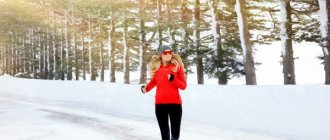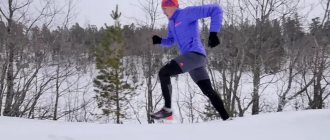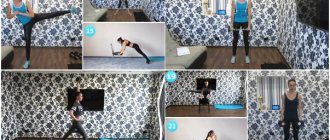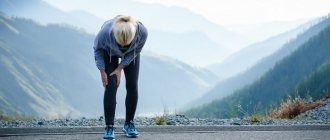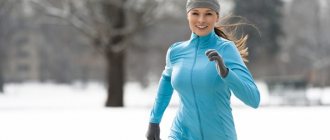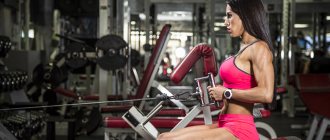First lessons
If you have already visited an orthopedist and chosen suitable shoes, then it’s time to start your first workout.
Set up your equipment
Don't worry that flat feet will prevent you from running. Are you walking? This means you can run. The main thing is to gradually switch to running. At a distance, you can replace it with walking. I wrote more about this tactic in the article “Running for Beginners.”
The first lesson, in general, can be done in the form of walking. Don’t let an imaginary gimlet drill into your thoughts because you couldn’t brag to your family about your jogging today. This will happen a little later.
Today and in the coming workouts, you need to improve your running technique. As you start, so things will go further. The same thing happens with skiers: if the track is laid well, then there will be positive results.
Trainer
It's good if you can agree with your athletics coach to correct your movements in the first days of classes.
Otherwise, see an orthopedist periodically. He will make sure that your feet are in order and suggest corrective exercises.
Tip Make friends with other runners who have been training for years. Perhaps among them there will be a person with flat feet. Such a friend will be able to save you from mistakes, especially in the first month of classes.
He will tell you not only what sneakers to wear, but also how best to tie them. Even a doctor can’t recommend anything that an experienced runner has tried.
Location
In the beginning, try to choose a running route where the track is not very rough. This will reduce the load on your legs when your feet touch the surface. A forest path or, better yet, a rubber stadium track will do, but not asphalt. An excellent alternative would be to choose a gym, at least for the first 3-4 weeks. In such establishments there is always an instructor who will guide your movements in the right direction. Be sure to tell him that you have flat feet. Then you can get additional recommendations for successful classes.
Assistive exercises
In autumn and spring, when there is slush and rain, you can do jumping instead of running or practice squats and jump rope at home.
A foot stretching exercise will do. To perform it, sit on the sofa, lift one leg off the floor and pull out your toes. Try to keep your foot arched. Do this 5-10 times with each leg.
You can train your feet by repeatedly rising on your toes and lowering onto your heels.
Can you run with flat feet?
If you have flat feet, it is extremely important to follow all the specialist’s recommendations regarding loads and exercises. There are standard rules associated with jogging with grade 2 and 3 leg disease:
- It's best not to do marathons. They can only do harm. If there is no professional trainer, you should rely on your own feeling, look at the reaction of the foot and legs when performing a certain running technique. Orthopedists advise doing light jogging at the beginning;
- The duration of the run should not exceed 30 - 40 minutes. At first, it is better to use the time within 20-30 minutes and observe the condition of the legs. If pain and other unpleasant sensations do not occur, after a week you can increase the load by 5 minutes, and after another 7 days by 5 minutes. As a result, running should take no more than 40 minutes;
- If the patient decides to run with flat feet, it is necessary to regularly see an orthopedist. This will help avoid complications and understand whether exercise helps improve the condition of the foot.
Correct running technique
It is better to invite a trainer for your first lessons. It will help you establish the correct technique and make training easier for your leg muscles. After proper running with flat feet becomes a habit and becomes automated, you can practice on your own.
Thanks to the latest developments in the design of sports sneakers, as well as the creation of special arch supports and sports orthopedic insoles, even people with flat feet have become able to practice running. However, you can start running after consulting with an orthopedic doctor, who will examine the patient to determine the degree of curvature of the foot and determine the acceptable level of load.
- With 1 degree curvature of the foot, running in combination with special exercises is considered an excellent prevention of flat feet, which will strengthen the muscular-articular system.
- At stage 2 of the disease, moderate physical activity is allowed. Short jogging is allowed. You need to run in special shoes with orthopedic insoles.
- Stage 3 flatfoot is characterized by complete deformation of the foot and constant pain that a person experiences even while walking. In this case, running is prohibited.
No flat soles
This recommendation applies to absolutely any shoe. The most “dangerous” are beach-type flip-flops. You should only wear those models whose style additionally supports the foot. Otherwise, the existing deformation will worsen.
The foot should not move to the right or left. Therefore, shoes should always be well laced. The size should be selected so that there is at least one centimeter of space in the sock, allowing the toes to be free.
Sneakers with arch support: examples of models from famous brands
In this section, we have given examples of sneakers in which you can run even with flat feet. Every major running brand has models with arch support, and any of them may be suitable, or they may be extremely uncomfortable - it depends on the individual. Try to buy models for overpronation with a fitting and do not get hung up on one brand.
Nike Air Zoom Structure 22
Sneakers with lateral support and more than 20 years of history. Suitable for overpronation of varying degrees and any distance. It is also recommended for people who are overweight and have weak foot muscles.
- Zoom Air cushioning and Duralon rubber in the front
- Engineered mesh
- Seamless upper with signature Flywire cables for a snug fit
- Dynamic Support and support insert on the inner part from the sole to the instep
- Weight of the male model – 295 g, female – 255 g
Asics Gel-Kayano 26
Asics Gel-Kayano 26 are the brand’s most technologically advanced sneakers in the stability category. For 26 years, the Kayano series has remained popular among running enthusiasts. Sneakers have changed their appearance, but cushioning, support, a comfortable last and versatility have always remained their calling card.
- Dynamic Duomax insert under the arch of the foot
- Asics signature Gel and FlyteFoam throughout the rest of the midsole
- MetaClutch rigid heel cage
- Stretch mesh upper with FluidFit technology
- Weight of the male model is 315 g, female – 260 g
with delivery to your home or office.
Kayano is the leader in the stability line. But there are decent options at a lower level. Less price, worse cushioning, but still the same excellent arch support.
Asics GT 2000 Ι Asics GT 1000
Hoka One One Gaviota 2
Hoka's most stable shoe with arch support. Rigid heel, reliable fixation of the foot in the middle. Unlike most other brands, Hoka has all-round Dynamic Stability foot support, not just on the medial side. The support forms a frame around the foot - J-Frame technology. The midsole features Hoka's traditional soft cushioning.
- Stabilizing J-Frame insert not only in the arch area, but also around the heel
- Thick midsole made of lightweight shock-absorbing foam
- Smooth transition from heel to toe
- The weight of the male model is 298 g, the female model is 244 g
Gaviota is suitable for long training sessions, marathons and ultramarathons. They are not demanding on technology and will direct their feet in the right direction. One of the best options for runners with flat feet (overpronation) and overweight beginner runners. Those with wide feet will find them a little narrow.
on Lamoda delivery to your home or office.
As an alternative to Gaviota, look at the Hoka One One Arahi 2 or Hoka One One Arahi 3. Similar technologies and purpose, different design and last, lower price tag.
Adidas Solarboost ST
The Solar series replaces the outdated Supernova, a popular sneaker for volume and tempo training. The Adidas Solarboost ST offers soft arch support and is suitable for runners with moderate overpronation. You can train in them for a marathon, run recovery runs, tempo workouts, use them as universal sneakers, and finish your first marathon. Balanced design with moderate support, cushioning and responsiveness.
- Boost foam midsole - one of the best in terms of shock absorption and elasticity
- Torsion System plate for torsional stability
- Stretchweb outsole made from Continental rubber, a renowned motorsport tire manufacturer
- Solar Propulsion Rail – EVA foam stabilizing foot frame
- Molded Fitcounter element in the heel area
- Weight of the male model – 289 g, female – 237 g
As an alternative for severe overpronation, consider the Adidas Solar Glide ST. They have a lower price tag, different upper materials, increased support and coarser cushioning.
Running with flat feet
Requires the use of special sports shoes. They should fit well on the foot so that the ankles do not move to the inside. Shoes should support your feet securely without any excessive cushioning.
Many well-known brands produce running shoes that provide additional arch support. The best models are the following: Saucony Omni 13, Nike LunarGlide 6, Asics GEL-Kayano and New Balance 860v4.
Running shoes must be properly sized and laced tightly when worn. They must meet all the requirements for such sports shoes.
Human foot and its functions
Such a disease as flat feet is familiar to many. And this is not surprising, because according to statistics, about 80% of the world's population suffers from one form or another of this musculoskeletal disease.
In this case, not only discomfort and pain appear.
A person is born with flat feet, and only by the age of 4 do the arches of the feet begin to form due to vertical load and mechanical stimulation.
How to find out if you have flat feet and whether you can run with it, answers sports doctor Vladimir Demchenko.
What is flat feet?
In total, there are two arches in the foot - longitudinal and transverse.
These are arched elastic structures supported by two systems: active (muscles) and passive (ligaments and tendons).
When running, there is a strong load on the foot, which can lead to worsening of the pathology - flat feet, and in the worst case - to injuries.
Flat feet is understood as a pronounced deformation of the foot when its arches are lowered. With such deformation, the feet lose their springing abilities and shock absorption.
Video. Flat feet - choosing shoes
Flat feet. How to treat flat feet?
Exercises for the treatment and prevention of flat feet.
Prevention of flat feet
- >
Flat feet. How to treat flat feet?
Treatment of flat feet at home.
- >
Exercises for the treatment and prevention of flat feet.
Simple and effective exercises for the treatment and prevention of flat feet.
- >
Precautionary measures
In order not to harm your health and not aggravate flat feet with systematic jogging, you first need to make sure that there are no contraindications to running. After this you can start training
It is important to follow some rules and safety precautions while running:
- Watch your running technique. If possible, it is advisable to work with a professional trainer. The specialist will detect errors in time that can aggravate problems with the foot, knees and spine during exercise.
- Strengthen the small muscles in your feet before running. It is useful to walk on the outer and inner sides of the feet alternately, as well as on the heels and toes.
- Massage your feet. To avoid pain and discomfort while jogging, you must first stretch your feet. To do this, it is recommended to walk on the ground, grass or small stones. In addition, you can purchase special massage mats with soft rubber spikes. It is recommended to massage your feet after running. This will relieve leg fatigue, restore muscle tone, activate blood circulation and lymphatic supply to the feet, as well as eliminate pain and increase the shock-absorbing functions of the foot.
- Dose physical activity. If you have flat feet, it is strictly forbidden to run with weights. The best solution is to jog for 30–40 minutes on unpaved surfaces.
- Buy special orthopedic insoles. The presence of instep supports will allow you to preserve the natural curves of the arch and provide additional support to your feet while running, preventing them from excessively spreading out.
Surgery for flat feet
The existing technology for performing the operation is very complex and is recommended only in extreme cases. However, in the United States of America, a new technique has been developed that has reduced the recovery period after surgery to several weeks.
This technology, called HyPro Cure, involves inserting a small titanium cylinder into the bony cavity of the foot without drilling. The cylinder supports and prevents the arch of the foot from descending.
Three stages of flat feet
Depending on the angle of the arch of the foot, there are three stages of development of flat feet. Their characteristic features determine the degree of neglect of the pathology.
- First. Fatigue of the feet during exercise, their pain. The deformation of the arch is insignificant and is in the nature of a cosmetic defect. At this stage, running, combined with a set of special exercises, will help strengthen the muscles and prevent further progressive pathologies.
- Second. Quite a pronounced pathology - a change in shape is already noticeable visually. At this stage, your legs hurt while walking, discomfort is felt in the ankle and foot area. The gait itself changes. Moderate loads are allowed.
- Third. Complete flattening of the surface of the foot, which is accompanied by pathological changes in the spine and joints. Even short walks cause pain. As a result, posture is disturbed, injuries to the knees, spine and other diseases appear.
The first two stages are acceptable for playing sports. While in the latter case, running and flat feet are incompatible. At the same time, the condition of each patient is individual, therefore, before starting training, it is necessary to consult with an orthopedist.
How to find out if you have flat feet
Flat feet is a disease that is often detected in the final stages, since many people attribute the onset of pathology to simple fatigue. Ignoring the first symptoms risks worsening the disease and giving up physical activity. At the same time, it is easy to find out about the presence of flat feet. This can be done without even leaving your home walls.
The algorithm of actions is as follows:
- Take a piece of paper - A4
- Get your feet wet
- Stand on the paper without leaning your elbows.
- Distribute the weight evenly.
- Examine the resulting print.
As a result, a notch should form on the inner edge of the foot. It should be a little more than half the total length. If the notch occupies less than half or about a third, then this indicates the first and second stages of flat feet, respectively. When there is no depression, this is a sign of the third, final stage of pathology.
However, all doubts can be dispelled and the diagnosis can only be confirmed or refuted by visiting an orthopedic center. A professional will accurately determine the presence of pathology, its type and stage. Timely treatment and prevention are the best tactics to combat the progression of flat feet.
Flat feet
The most common deformational change, affecting one or both feet, manifests itself in the lowering of the arch, against which the “arch” disappears. This pathology entails other consequences. In a person suffering from flat feet, the mechanics of the knee joints begin to work differently. This changes the distribution of normal load, the gait becomes different, and the posture worsens.
Approximately twenty percent of people living in developed countries have some degree of flat feet. This is facilitated by wearing uncomfortable and too narrow shoes, excess body weight, including weight gain by women during pregnancy.
Shoes for flat feet
Foot deformation manifests itself when choosing the wrong shoes for both running and normal walking. If the pair is not suitable, then overpronation of the foot occurs when the perpendicular position of the axis changes, that is, it begins to “fall” inward. This condition manifests itself by rapid wear of the outer part of the heels.
The left and right feet most often have varying degrees of flat feet. This creates some imbalance when the axis of the ankles shifts, which entails uneven deformation of the skeleton and distortion of the figure. To avoid such an unfavorable consequence, you need to wear special orthopedic shoes.
Recommendations and advice from professionals
If your orthopedist allows you to run, follow the basic recommendations. Since the foot should act as a shock absorber, you need to first take care of purchasing the right shoes. With stage 2 flat feet, it is necessary not only for running, but also for walking. This is the basis for the rules that should be followed when a person runs:
Selection of orthopedic shoes (insoles). On the recommendation of the doctor, purchase specialized shoes for running and walking, or buy orthopedic insoles. They are very comfortable and practical. The adhesive base helps to firmly secure the product at foot level; If you need to choose shoes, preference should be given to sneakers with high shock absorption, the right arch support, which does not bend the arch of the foot. Increased cushioning of running shoes for flat feet, a correctly selected size, and good foot circumference will make exercise not only enjoyable, but also useful. Insoles are chosen not by shoe size, but by feet. It is recommended in an orthopedic salon to apply them to the foot, the orthopedic protrusion should be above the arch, the heel should be in the right place. Today, many sports stores can offer specialized orthopedic insoles for running.
- Running technique also affects the disease. Only a professional trainer can determine the required pace and method of planting the foot. They will vary depending on the degree of pathology. Orthopedists advise alternating running with flat feet with general strengthening exercises that tone the arch of the foot. These include raising on your toes, rolling, squeezing your fingers in the girth. You should only run on soft surfaces so as not to injure your legs;
- It will be extremely useful in complex therapy to massage the foot after physical activity. Self-massage consists of rolling the foot on a rounded surface, walking on massage mats, soil, stones, grass, etc. You can perform rubbing, pressing on the legs, feet;
- Perform special exercises several times a day. Walking with flat feet on the outer and inner sides of the foot, on an inclined plane, high raising on the toes, and rolls is popular.
If you have flat feet and run, you should pay attention to the following tips:
- Use physical activity in doses (jogging should not exceed 40 minutes);
- Do not exceed the weekly volume of 50-60 km;
- It is worth combining running with general therapy, which will be prescribed by the doctor (in most cases, it consists of constantly wearing orthotics, performing massage and special exercises to develop the arch of the foot).
Gymnastics for flat feet
Special exercises cannot completely cure flat feet, but they help get rid of pain, if any, and increase endurance. The latter is of paramount importance for those who work while standing or running.
Special training involves performing exercises that develop the mobility of the toes, jogging and walking barefoot in the sand. In addition, you need to walk on your toes, as well as alternately on the inside and outside of your feet.
How to choose the right sneakers?
Running shoes will be more comfortable and last longer if they are selected for their intended purpose. To do this, you need to decide on the running location, surface, and season. Adequately assess your level of running fitness and check your body mass index.
Type of coverage and season
The main types are asphalt and off-road. Off-road conditions include dirt, mud and snow. For asphalt you need a minimal tread and good shock absorption; for dirt and snow - an aggressive tread on a stiffer sole. If your feet are cold, sneakers with a membrane - usually Gore-tex - are suitable as an insulated option.
Read more about the types of sneakers in our articles:
- Sneakers for running on asphalt
- Winter running shoes
- Off-road running shoes
Purpose: training or competitions
Training sneakers are used for daily jogging, so cushioning, stabilization, and wear resistance are important in them. Because of all the technology, such sneakers are heavier than competition ones and you can’t set records in them. But they have another goal - to maintain healthy muscles and joints, and they do this very well.
Competition sneakers are lighter than training shoes, have a thinner sole, and a minimum of support and stabilization systems. Usually such sneakers are called “marathon shoes”. Everyone decides for themselves whether such sneakers are needed. If you don’t have a goal to set personal records, marathon runners are unlikely to be useful.
Marathon running shoes
Pronation and fitness level
In skiing or cycling, you can still start with simple equipment, and then gradually move on to professional equipment. This principle does not work in running. Less experienced runners need more technical running shoes. They compensate for weak stabilizer muscles and relieve stress on ligaments and joints. Sneakers with support are a must for people with excess weight, flat feet, and problematic joints.
Runners with experience and proper technique can run in any running shoes without risk to health, practice “natural” running, and even run barefoot. Technical runners love “marathon” shoes – lightweight running shoes for maximum speed. For beginners, such shoes can lead to injuries, so we recommend that beginners use them only for working on equipment.
So, the worse the technique and physical form, the more cushioning and stability you need.
Pronation is an important factor when choosing running shoes, but it can limit your choice of shoes. In this case, orthopedic insoles will help. If for some reason the running shoes for overpronators are not suitable for you, choose a neutral model and try it on with your insoles.
Read on topic:
- What is pronation and supination?
- Sneakers for running on asphalt
- Sneakers for flat feet
- Marathon running shoes
Depreciation
The shock absorber was provided by nature before the advent of technological running shoes - this is the foot. For proper foot function when running, you need trained muscles and correct running technique. All runners pump up their feet, knees, back, abs - in general, they lean on general physical training. This takes time, but while you're working on it, run in shoes with good cushioning.
Each manufacturer has its own developments in depreciation, which it considers unique. Here are some of them:
- Adidas - Boost Foam
- Asics – special silicone Gel, FlyteFoam
- Hoka – Infuze Eva and Rmat foam, ProFly technology and other technologies
- Mizuno - Wave system
- Nike – Zoom air system, ZoomX, React foam
Read on: How are the soles of running shoes made?
Photo: triathlete.com
Ventilation
Ventilation in sneakers is much more important than insulation. Most running training and competitions take place in the hot season, and you don’t want to run with “burning” feet. Ventilation is also important for trail runners to overcome fords. Breathable sneakers quickly remove moisture and your feet become dry again.
Of course, to remove moisture from your shoes, you need good running socks - synthetic, moisture-wicking ones. Cotton ones will hold water regardless of the sneakers.
Almost all running shoe manufacturers produce running shoes with a membrane. The membrane is a special material that breathes and does not allow moisture to pass through. Sneakers with a membrane will keep your feet dry, but if you scoop up water through the top, they will gurgle until the end of the distance. Therefore, you should think carefully about whether you need a membrane at a distance. We prefer to use the membrane only for training in the city or park, where there is no chance of water getting through the upper of the shoe.
Drop or drop
Drop or drop is the difference between the sole height of the front and rear of the shoe. Not the most important factor in choosing running shoes, but you need to understand its purpose.
Answers to the most common questions about running shoes for overpronation
- Is it possible to run in regular running shoes with flat feet?
It is possible, but good depreciation is required. It is better to replace the standard insole with your own, made to fit the shape of the foot.
- Are running shoes suitable for natural running for an overpronator?
Only for special training on foot development and running technique. It is better not to run in them regularly.
- Are running shoes for overpronation only suitable for those with flat feet?
No. In running shoes for overpronators, you can run with neutral pronation, if comfortable. Especially long workouts and marathons, when the foot begins to collapse from fatigue.
- Will regular running shoes fit with orthotics?
Yes, you can add insoles to neutral sneakers. Better than nothing, but this design will be less stable, because the insole remains a soft base. Sneakers for flat feet have a hard insert in the sole; the insole will not provide such rigidity.
Physical activity incompatible with flat feet
Any orthopedist will tell you that physical activity for the development of the feet plays a big role in therapy, but they should only be performed under the close supervision of a doctor, or by following all his recommendations.
Worth knowing! Running with flat feet is not always possible. Whether it will be possible to combine sports and treatment depends on the degree of damage to the foot. To understand at what level the disease is located, you need to contact an orthopedist in time if you suspect the presence of its symptoms. He will tell you what tests to take to determine the extent of the disease.
Is it possible to play sports with flat feet? Flat feet are not a contraindication to sports, but there are certain restrictions. Figure skating, speed skating, hockey, ballet, classical jumping, tennis and badminton are not recommended.
Is it possible to do athletics? If we consider running and flat feet, then with this pathology it is impossible to run at a professional level. You can run with flat feet for short distances, gradually increasing the load.
The design with a thin tread and special instep support will provide good shock absorption.
Tips for Newbies
In the first months of training, flat feet can provoke pain in the knees and spine.
Your actions are as follows:
- Stop classes for 1-2 weeks. Everything should be restored.
- Choose a track with a softer surface.
If you have a large body weight, you can bandage your knees and ankles.
It is important
Be gentle and do not expose yourself to heavy stress. Regular running if you have flat feet will not only help you improve the shape of your feet, but also stabilize your weight.
Create conditions for your feet
Once you start running, the first thing you should remember every minute of your workout is to pay attention to your feet. A person cannot think about anything while awake
He needs somewhere to direct his attention. Let it not wander around somewhere and be filled with memories of yesterday's events, but let it occupy its feet. Think about them! After all, it is part of your body! Feel the energy that warms your feet.
When running, give your feet maximum comfort and the opportunity to correct flat feet. There are two methods to do this:
- Give your feet complete freedom.
- Place them in shoes that will give them shape.
Let's consider both options.
Freedom for your feet
This method will require you to develop a strict foot placement program, as you will have to gradually accustom yourself to running barefoot.
It's better to start outdoors in the warm season or you can go to the gym. Another option is to exercise at home if you have a running machine.
Tip When you run outside in cold weather, you can wear lined moccasins or other warm but lightweight shoes. The sole should be flexible enough that you feel as if you are training barefoot. But make sure your feet don't get cold.
By giving your legs freedom of movement, develop strict coordination of the movements of your feet. They should stand straight and apply pressure to the treadmill evenly over the entire area of the sole. When running, each leg needs to work in the following sequence:
- I touched the surface with my toe.
- She sank to her heel.
- I rose up on my toes when pushing off.
Try to avoid skewing your feet to one side or the other. Don't beat yourself up if it doesn't work out right now. Just remember this constantly. You will succeed. Give freedom to your subconscious. It will do what you want.
Why is it better to run in moccasins or barefoot? Because it forces the muscles that form the foot to be toned. Elastic shoes allow the foot to become lazy.
Foot support with shoes
If you decide to put your foot in a shoe that helps your foot maintain the correct shape, then you will have to tinker with the choice. But the time spent is worth it.
Don't start training until you provide yourself with comfortable and strong shoes! Otherwise, you risk getting quickly tired during classes, as well as pain and even injury. This may cause you to put off running for longer than you would otherwise spend searching for shoes.
Idea: After running, pay attention to your soles. If it wears off unevenly, it means you are positioning your feet incorrectly. The best option you should strive for is abrasion of the sole in the area of the base of the toes, which appears after several tens of kilometers
If the foot is positioned incorrectly, other areas of the sole are worn out first:
The best option you should strive for is abrasion of the sole at the base of the toes, which appears after several tens of kilometers. If the foot is positioned incorrectly, other areas of the sole are worn out first:
- Heel.
- External or internal side.
Let's start choosing sneakers.
What shoes are needed?
It should not spread out to the sides after a couple of days of wear when you take it off, but should retain the shape of your leg. Put on professional ski boots and you will understand what comfortable shoes are. These boots are warm, comfortable and support your feet. This is how you should feel in the sneakers you choose.
Please note that the soles of shoes that are designed to correct flat feet are special. From the side it resembles a rocking chair: the toe and heel are raised up. Inside, each sneaker follows the contour of the foot. This design helps to place your foot correctly at the moment of landing.
Basic rules when choosing shoes:
It is important that it is dense in width. You need to take one size larger so that your toes do not rest on the toe. Your sneaker should be tied so that the lace does not dig into your body and your foot does not move left and right.
Don't try to save money on this! It's better to avoid new sportswear, but your feet need to be kept comfortable. Don't be afraid to try on a hundred or two pairs of shoes in stores. When you find what you need, you will enjoy running and realize that your time was well spent.
Show sneakers for flat feet to a podiatrist before you wear them. He will tell you whether orthopedic insoles are needed. Purchase them if necessary.
This is interesting
- Correct posture when running and the benefits of running for posture and overall health
- Biomechanics of walking and running: what do you need to know about the biomechanics of human muscles?
- The benefits of running with chants and what songs to choose for running and training
Orthopedic insole
There are many situations in which people with flat feet need to wear flat shoes. If there is such a need, orthopedic insoles can provide foot support. It is necessary to remember that they will make the shoes much narrower.
It is recommended to buy insoles made taking into account individual characteristics, that is, made to order. When it is not possible to purchase these, even using ready-made models available for sale will be much better than just wearing shoes with flat soles.
The Best Running Shoes for Competition
Marathon and half-marathon running shoes are designed for intense but short-term exercise. Due to the thin sole, marathon shoes do not have a long service life, and they also do not always provide good shock absorption. Their main purpose is to provide the runner with optimal conditions to perform at their best in the competition. They are usually changed after every big race.
Mizuno Wave Rider 22 – a universal model for different surfaces
4.9
★★★★★ editorial assessment
94% of buyers recommend this product
See review
Mizuno running shoes are made of lightweight, breathable material. The AIRmesh mesh upper is well-ventilated and prevents your feet from overheating. The outsole features a unique Dynamotion Fit design that improves the fit of the shoe on your foot.
For added comfort, there is a foam midsection with a U4ic insert (for shock absorption and stabilization of impact with the ground), as well as a soft anatomical insole.
X-10 material was used to make the sole. It guarantees increased adhesion to the surface, is resistant to abrasion and negative atmospheric influences. Excess moisture is removed from the shoes through ventilation channels in the middle part of the sole. The weight of men's sneakers is 295 g, the height difference is increased to 12 mm.
Pros:
- Light weight.
- Excellent ventilation through the mesh upper and grooves in the outsole.
- Uniform cushioning.
- Anatomical insole.
- Tread for reliable traction.
- Stylish design.
Minuses:
- Not the most flexible sole, so push-offs are quite sensitive.
- The hard rubber makes running noisy.
The model is made in stylish and bright colors: the main black color of the upper is complemented by white and bright yellow inserts.
Salomon Sonic RA 2 - ultra-light running shoe with durable heat-sealed upper
4.8
★★★★★ editorial assessment
93% of buyers recommend this product
See review
The Sonic RA 2 features an improved adaptive fit, a comfortable seamless upper and innovative Energy Cell+ cushioning. The sneaker's manufacturing technologies combine seamless elastic inserts in the central part and on the sides of the toe, a dynamic fit to the foot and a precise fit of the shoe to the foot due to the internal tongue. Thanks to this, the sneakers provide good support for the foot, but do not restrict freedom of movement.
The upper materials include breathable mesh textiles and polyurethane overlays to protect the toes. An elastic composite sole and soft insole provide shock absorption and springiness while running and effectively absorb shock. And Geometric Decoupling technology allows you to quickly roll from heel to toe. A special tread is provided for additional grip on the surface.
Pros:
- Record light weight (220 g).
- Good shock absorption and effective vibration damping system.
- Suitable for running in the rain.
- Ventilated, seamless upper construction.
- There are pads to protect your fingers from impacts.
Minuses:
The price is above average.
Lightweight and comfortable sneakers provide comfortable running on various surfaces and in any weather.
Best running shoes for flat feet 2020
Nike Air Zoom Structure 21
Advantages:
- Seamless upper with signature Flywire cables for a snug fit.
- Foam sole of different densities. The foam on the inside of the foot is denser, while the rest of the sole is soft.
- Rigid heel counter for heel support.
- Cushioning with compressed air capsules (branded Zoom Air).
- 278 grams in size 9 US.
Main complaints from runners:
- too hard heel
- uncomfortable insole
Negative reviews of Nike Structure are mainly related to the characteristics of the feet of a particular runner. To avoid troubles, choose the right sneakers in the store or order them with a fitting.
Buy Nike Structure with fitting on Lamoda.
Buy Nike Structure on the official Nike website. There is a possibility of return within 30 days.
ASICS GEL-Kayano 24
Standard “gentleman’s” set of hyperpronator:
- Dynamic Duomax insert under the arch of the foot
- Asics signature Gel and FlyteFoam throughout the rest of the midsole
- MetaClutch hard back
- FluidFit stretch mesh
- 320 grams in size 9 US
The Caiano is not the lightest running shoe. Probably due to the gel and many stabilizing elements. The gel absorbs shock, but makes the sneaker heavier.


